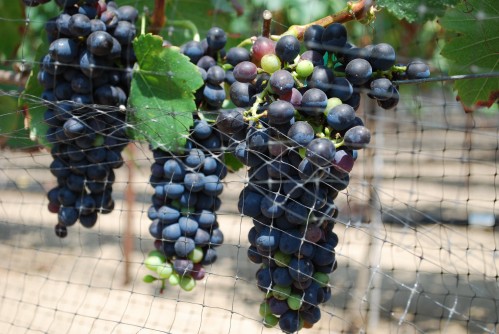 Here at Domaine de Manion, our backyard syrah vineyard, it is late summer and our syrah grapes are showing their true color. Our syrah grapevines have a full vegetative leaf canopy, perfectly formed grape clusters dangle from their shoots, and now the veraison process begins. Veraison is the phenomenon of grapes transitioning in their development from hard to soft in touch, and their color transitions from green to their harvest color, depending on the grape varietal. Syrah, our vineyard grape varietal, is a very dark, inky black color when ripe and at harvest time. In the above photo you can see the color transition happening among the individual grapes.
Here at Domaine de Manion, our backyard syrah vineyard, it is late summer and our syrah grapes are showing their true color. Our syrah grapevines have a full vegetative leaf canopy, perfectly formed grape clusters dangle from their shoots, and now the veraison process begins. Veraison is the phenomenon of grapes transitioning in their development from hard to soft in touch, and their color transitions from green to their harvest color, depending on the grape varietal. Syrah, our vineyard grape varietal, is a very dark, inky black color when ripe and at harvest time. In the above photo you can see the color transition happening among the individual grapes.
In this process, the grape's sugar level will slowly begin to rise. Regular testing of your grape sugar content with a refractometer helps monitor your harvest time frame.
When grapes transition from green to their varietal harvest color of yellow, pink, red, or black, it is a signal to birds and wildlife, a food source is available and ripening. Netting your grapevines is invaluable in protecting your grapes from birds, raccoons, deer, and wildlife in general. Even our beloved chickens love the ripening grape clusters, jumping nearly a foot to reach the clusters, if they are not netted.
Our netting system is simple. Measure out netting the entire length of each of your grapevine row, and allow 3' on each end to secure the netting ends. Throw the entire netting over both sides of your grapevine row, and clip at bottom with wooden clothespins at spaced intervals. These nets can be used year after year, if rolled up and secured away in a safe place until needed the following year. Netting your backyard vineyard ensures your entire year's efforts and crop will not be lost. Netting is particularly important to the backyard vineyard, which is generally isolated, versus commercial vineyards where there are acres and acres of growing grapes.
It is an exciting time of year, harvest is in a matter of weeks. Do you have a backyard vineyard? Do you net your grapes from wildlife?



 Here at Domaine de Manion, our backyard syrah vineyard, it is late summer and our syrah grapes are showing their true color. Our syrah grapevines have a full vegetative leaf canopy, perfectly formed grape clusters dangle from their shoots, and now the veraison process begins. Veraison is the phenomenon of grapes transitioning in their development from hard to soft in touch, and their color transitions from green to their harvest color, depending on the grape varietal. Syrah, our vineyard grape varietal, is a very dark, inky black color when ripe and at harvest time. In the above photo you can see the color transition happening among the individual grapes.
Here at Domaine de Manion, our backyard syrah vineyard, it is late summer and our syrah grapes are showing their true color. Our syrah grapevines have a full vegetative leaf canopy, perfectly formed grape clusters dangle from their shoots, and now the veraison process begins. Veraison is the phenomenon of grapes transitioning in their development from hard to soft in touch, and their color transitions from green to their harvest color, depending on the grape varietal. Syrah, our vineyard grape varietal, is a very dark, inky black color when ripe and at harvest time. In the above photo you can see the color transition happening among the individual grapes.